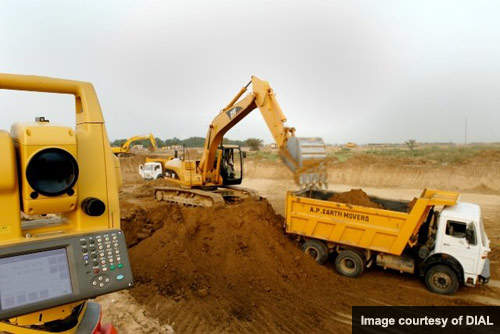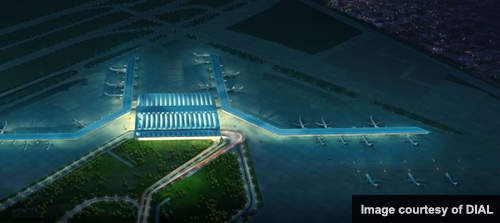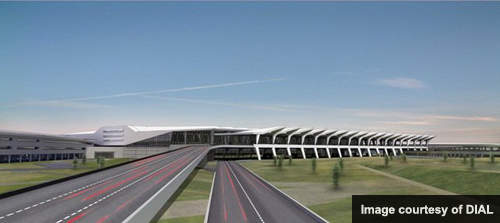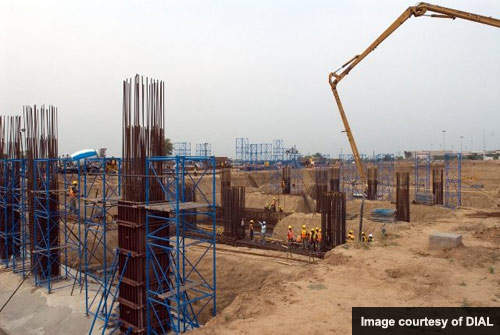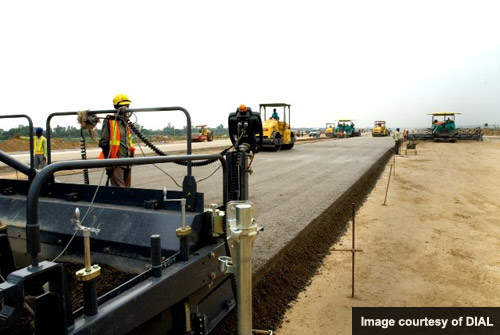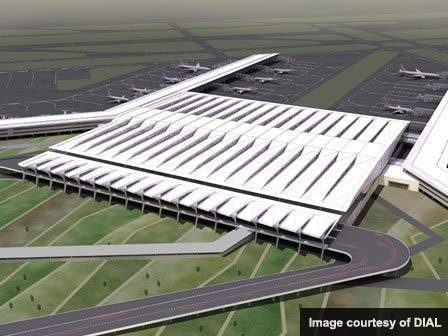Indira Gandhi International (IGI) Airport, which was named after one of India’s most well known prime ministers, serves the city of Delhi which is about ten miles (16km) away. The airport, covering a 1,900-acre site, has two runways 10/28 (12,500ft 3,810m) and also an auxiliary runway 09/27 (9,229ft 2,813m). The main runway 10/28 is also one of the few runways in Asia that is equipped with a CAT III-B instrument landing system allowing landing in visibility as low as 50m.
The airport, which is the second busiest in India hosted 20.44 million passengers in 2006–2007 (domestic and international) and currently has six terminals including: domestic terminals 1A, 1B and 1D, the international terminal two, the Haj terminal and international cargo terminal.
Delhi International Airport operator
The airport is operated by Delhi International Airport Ltd (DIAL) which is a consortium led by an Indian developer, GMR Group, and including Fraport AG, Eraman Malaysia, India Development Fund and Airports Authority of India.
The expansion project is being carried out under the Public Private Partnership Initiative of the government of India. DIAL was awarded the modernisation and restructuring contract for the airport in January 2006 after submitting the winning bid. DIAL have developed a master plan for development of the airport over the next 30 years.
In addition they have a concession to run the airport for 35 years with an option to extend the arrangement for a further 30 years. The whole renovation and expansion programme is expected to cost $2bn.
Indira Gandhi International Airport modernisation and expansion
DIAL took over IGI Airport in May 2006 and immediately undertook a renovation programme for the existing 1A and 1B terminals as a stop gap measure to give them a modern look (this included seating, lighting, decoration inside and out, air conditioning and toilets). Terminal 1D was opened in February 2009, increasing the departure capacity of the airport to 10 million passengers a year.
Renovation of terminal two was completed in July 2008. Modernisation works at the terminal included a new three-level in-line baggage-handling system, 22 additional check-in booths and a new customs and immigration area. The terminal now has 100 check-in counters and 52 immigration counters in the departure area and 48 counters in the arrival area.
The main emphasis is being put on the major expansion programme currently underway at the airport (phase one). This will include the construction of a new terminal three (T3) which will require an investment of over $700m and be ready in time for India to host the Commonwealth Games in 2010.
The new terminal will give the airport a capacity of 37 million passengers a year.
Also a new code-F parallel runway (4,430m x 60m) was opened for commercial operations in September 2008. The runway is one of the longest in Asia and has CAT IIIB ILS capability.
Terminal three
Terminal three (330m by 250m) (will handle 100% of international and 50% of domestic traffic when it is opened), which will have a floor space of 480,000m² was designed by HOK in consultation with Mott McDonald and is being constructed by Larsen and Toubro, Meinhardt Engineering and Airbiz of Australia (airport planner) with project management by Parsons Brinckerhoff International Inc.
The interior and retail design is being carried out by Woodhead of Australia. The terminal will feature 74 aerobridges, 30 remote parking bays for passenger movement to and from the aircraft and 78 boarding bridges. Six of the aerobridges will be compatible with the A380.
The terminal (roof height 27m) will also have a five level in-line baggage handling system and 160 check-in counters as well as 70 desks for immigration. Siemens Mobility has won the contract to supply the baggage handling system, which can handle more than 11,300 pieces of baggage per hour.
The building will be on two levels with departures on the upper floor and arrivals on the lower. Passengers that have checked-in will pass over a bridge to the airside and will be able to look down to the arrivals floor from the bridge.
The terminal will also have extensive shopping areas (Alpha has the duty free contract), with many restaurants and bars and executive lounges to relax in. There will also be a business centre with state-of-the-art IT and communications equipment for the business traveller.
In June 2009 DIAL announced a joint venture with the consortium comprising Ireland travel retailer Aer Rianta International and Indian Duty Free Services to develop, operate, maintain and manage duty-free outlets at Terminal 3.
The new terminal will have road access via a new six lane road from NH-8 and will also have a high-speed metro line to the city (metro line (Delhi Airport rail link) funded by DIAL and with three stations) with special city check-in facilities. There will also be an integrated 4,300-space multi-storey car park at the terminal.
Subsequent phases
The building of T3 is just the first phase of the airport development. In later stages a new cargo terminal will be built and additional passenger terminals and a new runway (eventually the secondary runway 09/27 will be realigned and extended). The passenger terminals will be added in a modular fashion to eventually form a U-shaped complex.
Passenger numbers at the airport are expected to rise to 46 million a year by 2015 and 80 million a year by 2025 (final capacity of the airport may reach 100 million passengers a year).
The airport expects to build four new terminals and a fourth runway by 2026. With the airport developing to the size of a small city DIAL will also take a leaf out of Hong Kong’s book and build an ‘aircity’ around the airport with shops, hotels, convention centres and recreational facilities for travellers.

